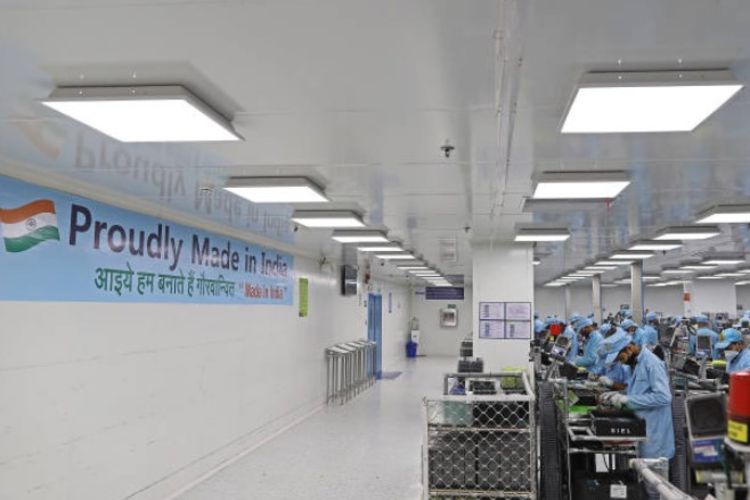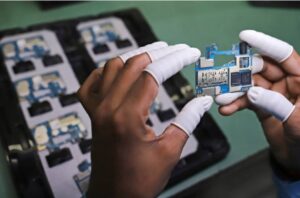
Amid rising geopolitical tensions and the re-escalation of the US-China trade war under President Donald Trump, India may find an unexpected strategic opening. As Washington doubles down on dismantling China’s dominance in electronics manufacturing—especially in smartphones, laptops, and PCs—India has emerged as a likely beneficiary of global supply chain realignments.
According to Counterpoint Research, China’s grip on global smartphone production is projected to shrink from 64% in 2024 to 55% by 2026, largely due to the tariffs and curbs imposed by the US. In contrast, India’s share is expected to climb from 18% to 25–28% over the same period. This shift is not just driven by geopolitics; New Delhi’s proactive policy push—particularly tax breaks for new manufacturing units and simplified export procedures—has created a more attractive investment environment.
READ | India, US race against time to seal bilateral trade agreement
Tailwinds from US-China trade war
The timing aligns well with India’s flagship Make in India initiative. For instance, Apple has already begun ramping up production in India, with 20% of its global output now originating from the country. That share could rise to 25% by 2025–26, and to as much as 35% by 2026–27. In effect, one in every three iPhones may soon be Made in India. This is a significant endorsement of India’s production-linked incentive (PLI) scheme for mobile manufacturing.

Despite these gains, India’s electronics manufacturing story remains uneven. While smartphone manufacturing has become the poster child of the PLI scheme, other segments—particularly laptops and PCs—continue to lag. This is crucial because the US alone imports about $21 billion worth of laptops and PCs annually, of which nearly 80% are sourced from China.
Counterpoint projects China’s share of global laptop production will decline from 75% in 2024 to around 68–70% by 2026. This opens a window of opportunity for India, but the question is whether it can capture it. Currently, India’s contribution to the global laptop value chain stands at a meagre 1%, in a segment valued at $200 billion per year.
If global majors such as HP and Dell begin relocating a part of their manufacturing to India, as they have with smartphones, the country’s production share could rise to 7% by 2026—up from less than 4% in 2024. A substantial ramp-up would require targeted incentives, policy stability, and infrastructure upgrades. The PLI scheme for IT hardware, while a step in the right direction, may need recalibration to match the scale and complexity of this opportunity.
Driving value addition
India’s electronics sector is evolving beyond simple assembly. According to an Axis Capital report, value addition in smartphone manufacturing has risen from 30% to nearly 70%, with projections suggesting it could reach 90% by FY27. This is crucial for creating high-quality jobs and fostering a domestic ecosystem of suppliers, designers, and component manufacturers.
To sustain this momentum, mobile phone makers are lobbying for an extension of the PLI scheme beyond its current 2026 deadline. They argue that continuity will enable deeper localisation and eventually lead to indigenous product design—a critical missing link in India’s electronics value chain.
However, the laptop and PC segment is still heavily dependent on imports. Industry insiders note that most of India’s domestic demand is currently met by shipments from China. If India can emulate its mobile manufacturing playbook in this segment, it could begin to chip away at China’s entrenched position.
Competition from Mexico, Vietnam and others
India’s ambitions, however, face stiff competition. According to Canalys, 79% of Dell’s laptops were manufactured in China in 2024, with the remainder produced in Vietnam. By 2026, over half of Dell’s production is expected to shift to Vietnam. HP, which currently produces 85% of its laptops in China, is increasingly relying on Taiwan and Mexico. Lenovo, too, plans to expand operations in Vietnam, where it made just 1% of its laptops in 2024.
These countries are not just quicker to adapt—they offer significant structural advantages. Vietnam boasts lower labour costs, a mature supply chain for electronics, and a track record of consistent policy support. Mexico, by contrast, offers proximity to the US market and tariff-free access through the USMCA trade agreement, along with a well-established electronics base.
India, despite its large domestic market and improving policy framework, still struggles with relatively high tariffs on components, a less-developed component manufacturing ecosystem, infrastructural bottlenecks, and a reputation for policy unpredictability. These issues dilute India’s appeal to manufacturers looking to de-risk operations from China quickly and efficiently.
To position itself as a serious alternative to China, India must go beyond short-term incentives. Policymakers need to focus on building a long-term vision that addresses structural weaknesses—ranging from logistics to skill development to component manufacturing. Industry players are calling for a stable and transparent regulatory environment, better ease of doing business, and faster customs clearances.
If India can meet these challenges head-on, it may not only attract global investment but also solidify its position as the world’s next electronics manufacturing hub. But the clock is ticking. The decisions taken in the next two years—both by industry and government—could define India’s role in global supply chains for the next two decades.
